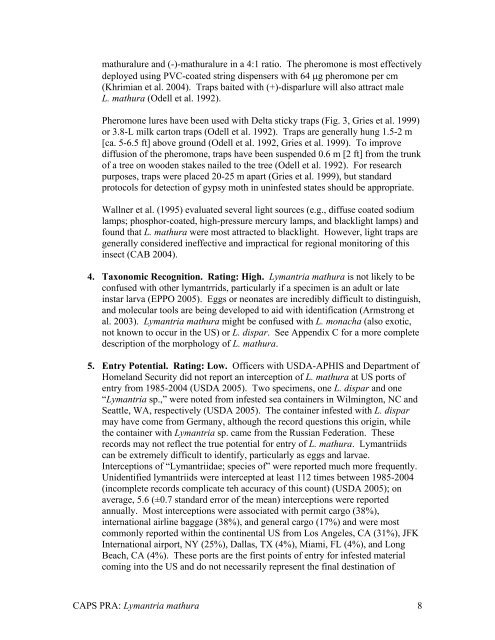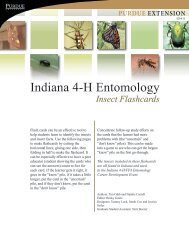Pink Gypsy Moth - aphis - US Department of Agriculture
Pink Gypsy Moth - aphis - US Department of Agriculture
Pink Gypsy Moth - aphis - US Department of Agriculture
You also want an ePaper? Increase the reach of your titles
YUMPU automatically turns print PDFs into web optimized ePapers that Google loves.
mathuralure and (-)-mathuralure in a 4:1 ratio. The pheromone is most effectively<br />
deployed using PVC-coated string dispensers with 64 µg pheromone per cm<br />
(Khrimian et al. 2004). Traps baited with (+)-disparlure will also attract male<br />
L. mathura (Odell et al. 1992).<br />
Pheromone lures have been used with Delta sticky traps (Fig. 3, Gries et al. 1999)<br />
or 3.8-L milk carton traps (Odell et al. 1992). Traps are generally hung 1.5-2 m<br />
[ca. 5-6.5 ft] above ground (Odell et al. 1992, Gries et al. 1999). To improve<br />
diffusion <strong>of</strong> the pheromone, traps have been suspended 0.6 m [2 ft] from the trunk<br />
<strong>of</strong> a tree on wooden stakes nailed to the tree (Odell et al. 1992). For research<br />
purposes, traps were placed 20-25 m apart (Gries et al. 1999), but standard<br />
protocols for detection <strong>of</strong> gypsy moth in uninfested states should be appropriate.<br />
Wallner et al. (1995) evaluated several light sources (e.g., diffuse coated sodium<br />
lamps; phosphor-coated, high-pressure mercury lamps, and blacklight lamps) and<br />
found that L. mathura were most attracted to blacklight. However, light traps are<br />
generally considered ineffective and impractical for regional monitoring <strong>of</strong> this<br />
insect (CAB 2004).<br />
4. Taxonomic Recognition. Rating: High. Lymantria mathura is not likely to be<br />
confused with other lymantrrids, particularly if a specimen is an adult or late<br />
instar larva (EPPO 2005). Eggs or neonates are incredibly difficult to distinguish,<br />
and molecular tools are being developed to aid with identification (Armstrong et<br />
al. 2003). Lymantria mathura might be confused with L. monacha (also exotic,<br />
not known to occur in the <strong>US</strong>) or L. dispar. See Appendix C for a more complete<br />
description <strong>of</strong> the morphology <strong>of</strong> L. mathura.<br />
5. Entry Potential. Rating: Low. Officers with <strong>US</strong>DA-APHIS and <strong>Department</strong> <strong>of</strong><br />
Homeland Security did not report an interception <strong>of</strong> L. mathura at <strong>US</strong> ports <strong>of</strong><br />
entry from 1985-2004 (<strong>US</strong>DA 2005). Two specimens, one L. dispar and one<br />
“Lymantria sp.,” were noted from infested sea containers in Wilmington, NC and<br />
Seattle, WA, respectively (<strong>US</strong>DA 2005). The container infested with L. dispar<br />
may have come from Germany, although the record questions this origin, while<br />
the container with Lymantria sp. came from the Russian Federation. These<br />
records may not reflect the true potential for entry <strong>of</strong> L. mathura. Lymantriids<br />
can be extremely difficult to identify, particularly as eggs and larvae.<br />
Interceptions <strong>of</strong> “Lymantriidae; species <strong>of</strong>” were reported much more frequently.<br />
Unidentified lymantriids were intercepted at least 112 times between 1985-2004<br />
(incomplete records complicate teh accuracy <strong>of</strong> this count) (<strong>US</strong>DA 2005); on<br />
average, 5.6 (±0.7 standard error <strong>of</strong> the mean) interceptions were reported<br />
annually. Most interceptions were associated with permit cargo (38%),<br />
international airline baggage (38%), and general cargo (17%) and were most<br />
commonly reported within the continental <strong>US</strong> from Los Angeles, CA (31%), JFK<br />
International airport, NY (25%), Dallas, TX (4%), Miami, FL (4%), and Long<br />
Beach, CA (4%). These ports are the first points <strong>of</strong> entry for infested material<br />
coming into the <strong>US</strong> and do not necessarily represent the final destination <strong>of</strong><br />
CAPS PRA: Lymantria mathura 8
















